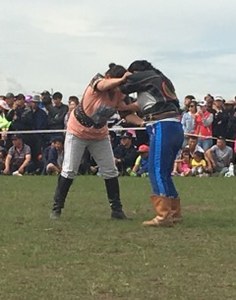The Gentle Sport of Wrestling Mongolian-style
This past summer, I had occasion to visit Hailar City in the District of Hulunbuir, in northeast Inner Mongolia Autonomous Region, China. I arrived during the summer festival of Naadam, known locally as eriin gurvan naadam, that is, the “three games of men.” Held beyond the city in the Hulunbuir Grasslands, the games consist of horse racing, archery and wrestling. But not only men participate in these popular sports. I was in time to see the wrestling competitions between women.
Mongolian wrestling (Mongolian, Bökh) is unlike the sport or spectacle that we know in the west. It is still a spectacle, since wrestlers wear short studded leather or colorful sleeved tops that leave the chest exposed (zodog) and tight shorts (shuudag) or in Inner Mongolia, embroidered knee-length trousers, along with leather boots (gutal), often with slightly turned up toes.
There are no age limits or weight divisions so that someone small can be pitted against someone twice his (or her) weight. Matches have no time limit but end when one of the wrestlers gets his (or her) opponent to touch back, knee or elbow to the ground; in Inner Mongolia one only has to get any body part, other than the feet, of course, to touch the ground. Further, it is forbidden to touch one’s opponent’s legs with one’s hands.
As an art historian who studies the visual cultures of Iran and Central Asia, I’m on the lookout for modern parallels with ancient art. The action and poses struck by these wrestlers brought-to-life the bronze belt plaques showing pairs of wrestling men that have been found or excavated in the frontier regions of Northern China (the Ordos, Ningxia province and Inner Mongolia) and were fashioned in the Qin and Han Dynastic period, i.e., between the end of the 3rd century BCE and the beginning of the 3rd century CE.
In addition to the rules of the match, Mongolian wrestling has certain codes of conduct to ensure good sportsmanship. Thus, when a wrestler’s clothes become loose or entangled, his (or her) opponent is expected to stop the attack and help the former to re-arrange them, despite the possibility of giving up a potential winning maneuver. Several times in the course of the women’s matches, the action was halted so that one of the women could retie her topknot, and this was often accomplished with

Now, almost four months later, I think a lot about the goodwill expressed by the combatants, the referees (some of whom were women) and the friendly, appreciative audience in this relatively remote territory.

